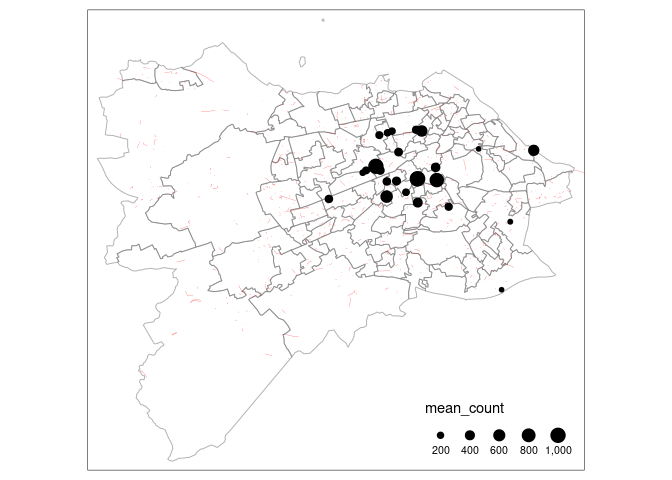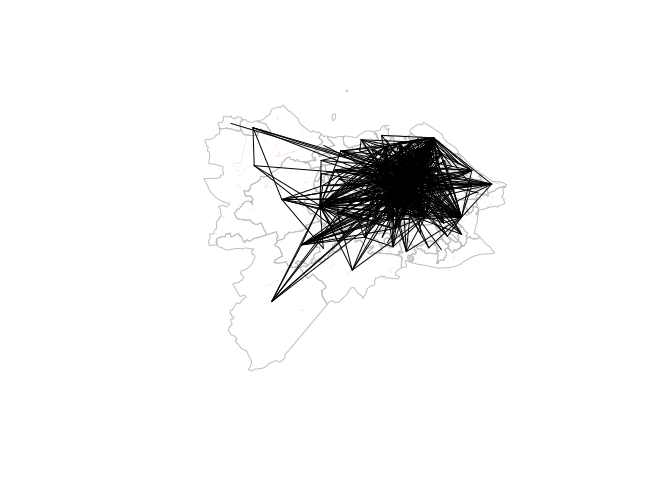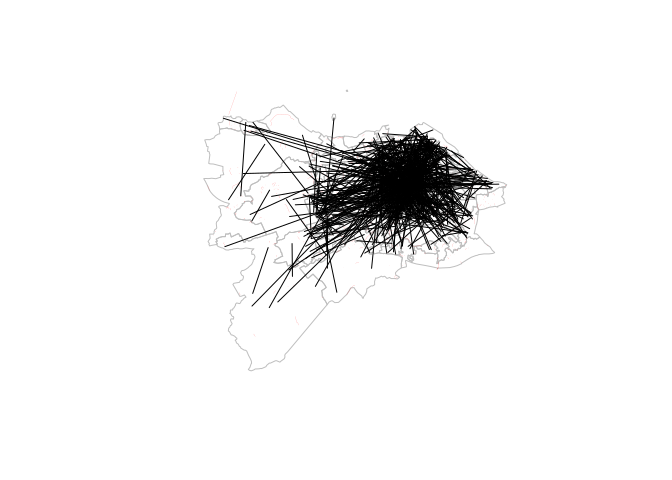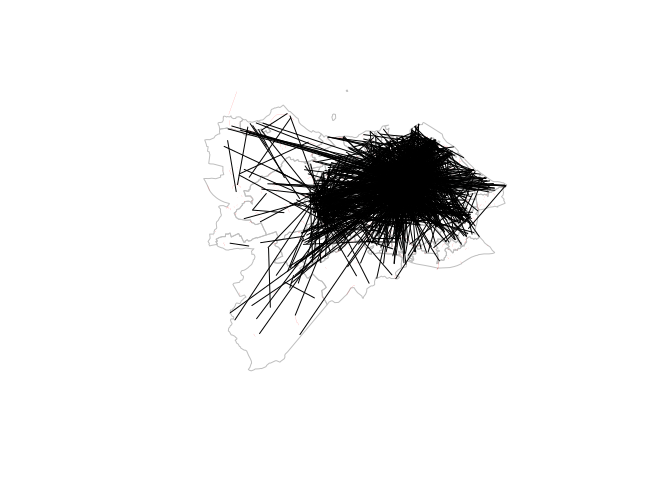Disaggregating origin-destination data: methods, implementations, and optimal parameters for generating accurate route networks for sustainable transport planning
Origin-destination (OD) datasets are used to represents movement through geographic space, from an origin (O) to a destination (D). Also referred to as ‘flow data’1 OD datasets usually contain not only information about where they start or end, but also about the amount of movement between zones (which are often represented by a zone centroid) or other geographic entities. Because of their ability to encode a large amount of information about millions of trips in a relatively small amount of storage space, with the maximum number of rows in an aggregate OD dataset equal to square of the number of zones squared, including intra-zonal OD pairs. Thus, the entire transport system of London can be represented, albeit simplistically, as an OD dataset representing movement between the city’s 33 boroughs with only 33^2 (1089) rows and a number of columns depending on the number of trip types.
Because of these easy-to-use characteristics, OD datasets have long been used to describe aggregate urban mobility patterns (Carey, Hendrickson, and Siddharthan 1981). Typically, OD datasets are represented geographically as straight ‘desire lines’ between zone centroids, with all trips shown as departing from and arriving to a single centroid per zone, for convenience, simplicity and (historically) to reduce computational requirements. This approach, illustrated in Figure ?? below, has formed the basis of many visualisations and research projects using OD data (e.g. Rae 2009; Calabrese et al. 2011).
Connecting zones with straight lines in this way has advantages: it can provide a quick summary of the movement patterns between zones, particularly when attributes such as total number of trips and the percentage of trips made by a particular mode are represented by variable aesthetics such as line width and colour, as illustrated in Figure ??.
However, the approach has limitations, including:
- people do not travel in straight lines!
- centroid-based desire lines obscure two-way flows (Tennekes and Chen 2021)
- incorrect concentration of travel around certain points
One way to add richness and realism to OD data is to convert the geographic desire lines into routes on the network and then aggregate the associated data to the route segment level to create route network outputs (Morgan and Lovelace 2020). Route network generation from centroid-based desire lines addresses limitations 1 and 2 outlined above, but not 3. In this paper we explore the potential for different ‘jittering’ and disaggregation approaches to address limitations 1 to 3. Unlike some previous methodological papers on OD data, we are not only concerned with the visualisation of the data. The aim is to not only create informative visualisations but also to generate accurate results, measured as a correlation between estimated flow on the network from the route network results and real world datasets, and valuable open access datasets for subsequent geographic analysis steps.
The geographic input datasets on which the analysis presented in this paper build are cleaned versions of open datasets representing the transport system in Edinburgh (see Figure 2.1):
- Open access cycle counter data, stored in
cycle_counts_edinburgh_summary_2020-03-02-2022-01-05.geojson - Open zones data, stored in
iz_zones11_ed - Open road network data from OSM, stored as
road_network_ed.geojson
A non-geographic OD dataset representing trips between the zones was also generated and saved as a .csv file, the first three elements of which are presented in the table below.
| geo_code1 | geo_code2 | all | from_home | train | bus | car_driver | car_passenger | bicycle | foot | other |
|---|---|---|---|---|---|---|---|---|---|---|
| S02001576 | S02001576 | 151 | 0 | 0 | 6 | 61 | 7 | 5 | 70 | 2 |
| S02001576 | S02001577 | 132 | 0 | 0 | 11 | 84 | 10 | 11 | 15 | 1 |
| S02001576 | S02001578 | 40 | 0 | 0 | 5 | 32 | 2 | 0 | 1 | 0 |
Table 2.1: Sample of three rows from the OD dataset used in this paper.
To test the performance of different parameters and settings for the OD-to-route-network conversion process, we focussed only on cycling trips as these were measured in the counter dataset mentioned. The following parameters were adjusted to explore their importance, in roughly descending order of frequency of mentions in the literature:
- The routing profile used, which can ‘prefer’ differet route types, resulting in ‘quiet’ to ‘fast’ networks (Desjardins et al. 2021)
- The level of disaggregation, ranging from none to full disaggregation (on desire line and route per trip) (Jafari et al. 2015)
- Jittering strategy used to sample origin and destination points within zones (Lovelace, Félix, and Carlino 2022)
The jittering process was undertaken with the Rust crate odjitter,
which can be replicated using the following reproducible code run from a
system terminal such as Bash on Linux, PowerShell on Windows or the Mac
Terminal
(Cargo
must be installed for this to work).
First install the odjitter Rust crate and command line tool:
cargo install --git https://github.com/dabreegster/odjitterGenerate jittered OD pairs with a max-per-od value of 50 as follows:
Try running it with a different max-per-od value (10 in the command
below):
#> [1] 3367
Generate results for top 500, run once:
Figure ?? shows the output
of the jitter commands above visually, with/without jittering and with
different values set for max-per-od.
The approach is not without limitations.
Acknowledgement should be made of any funding bodies who have supported the work reported in the paper, of those who have given permission for their work to be reproduced or of individuals whose particular assistance is due recognition. Acknowledge data providers here where appropriate.
All contributing authors should include a biography of no more than 50 words each outlining their career stage and research interests.
Dustin is a software engineer at the Alan Turing Institute, where he’s creating an ecosystem of interoperable digital twins to study urban transportation and pandemics. He’s the creator of the A/B Street transportation planning platform, and a proponent of open source code and the Rust programming language.
Calabrese, Francesco, Giusy Di Lorenzo, Liang Liu, and Carlo Ratti. 2011. “Estimating Origin-Destination Flows Using Mobile Phone Location Data.” IEEE Pervasive Computing 10 (4): 36–44. https://doi.org/10.1109/MPRV.2011.41.
Carey, Malachy, Chris Hendrickson, and Krishnaswami Siddharthan. 1981. “A Method for Direct Estimation of Origin/Destination Trip Matrices.” Transportation Science 15 (1): 32–49. https://doi.org/10.1287/trsc.15.1.32.
Desjardins, Elise, Christopher D. Higgins, Darren M. Scott, Emma Apatu, and Antonio Páez. 2021. “Correlates of Bicycling Trip Flows in Hamilton, Ontario: Fastest, Quietest, or Balanced Routes?” Transportation, June. https://doi.org/10.1007/s11116-021-10197-1.
Jafari, Ehsan, Mason D. Gemar, Natalia Ruiz Juri, and Jennifer Duthie. 2015. “Investigation of Centroid Connector Placement for Advanced Traffic Assignment Models with Added Network Detail.” Transportation Research Record: Journal of the Transportation Research Board 2498 (June): 19–26. https://doi.org/10.3141/2498-03.
Lovelace, Robin, Rosa Félix, and Dustin Carlino. 2022. “Jittering: A Computationally Efficient Method for Generating Realistic Route Networks from Origin-Destination Data,” January. https://doi.org/10.31219/osf.io/qux6g.
Morgan, Malcolm, and Robin Lovelace. 2020. “Travel Flow Aggregation: Nationally Scalable Methods for Interactive and Online Visualisation of Transport Behaviour at the Road Network Level.” Environment & Planning B: Planning & Design, July. https://doi.org/10.1177/2399808320942779.
Rae, Alasdair. 2009. “From Spatial Interaction Data to Spatial Interaction Information? Geovisualisation and Spatial Structures of Migration from the 2001 UK Census.” Computers, Environment and Urban Systems 33 (3): 161–78. https://doi.org/10.1016/j.compenvurbsys.2009.01.007.
Tennekes, Martijn, and Min Chen. 2021. “Design Space of Origin-Destination Data Visualization.” Computer Graphics Forum 40 (3): 323–34. https://doi.org/10.1111/cgf.14310.
 of open access data from the 2011 Census. Illustration of typicall representation of OD dataset, illustrating travel to work patterns in England. Source: author's [analysis](https://github.com/creds2/od-data) of open access data from the 2011 Census.](https://raw.githubusercontent.com/temospena/odnet/main/overview_map1.png)




